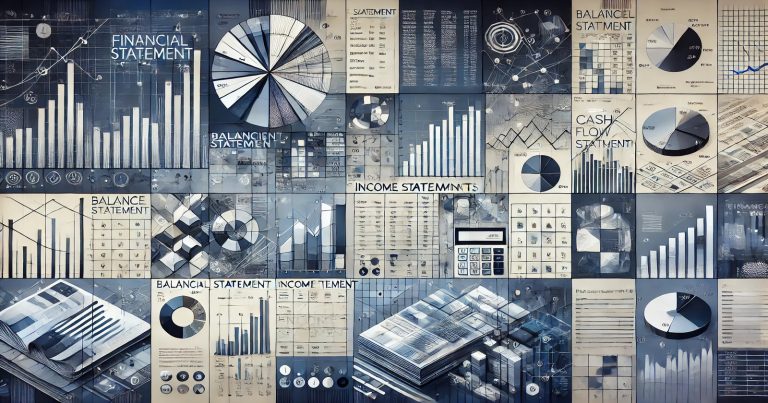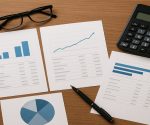An example of a financial statement shows how a company accounts for its income, expenses, assets, and liabilities. Now it has three main reports – income statement example, balance sheet example and cash flow statement example. These statements reveal how a company earns, spends, and saves money. These instances also make accounting easier whether you’re a student, a small business owner or an investor. Resoucre: Financial Statement Example to Monitor Business Health Explain financial statement format, financial statement analysis example, types of statements in simple way for Indian learners.
Sample of Financial Statement for Small Business
A small business uses financial statements to track its income, expenses and savings. It enables them to make better money choices. An illustration of a financial statement for small business shows an authentic picture of a business’s assets, liabilities and income. These statements are also meant to demonstrate this to banks and investors.
Financial Statement Example
A small business will prepare three key statements monthly or annually. These are:
- Income Statement Example: How much money and expenses
- Balance sheet example: Gives what the business owns and owes.
Example of a Cash Flow statement: Displays cash flow in and out of the business.
Below is an example of an income statement of a small bakery in Mumbai:
| Particulars | Amount (INR) |
| Sales | ₹1,00,000 |
| Cost of Goods Sold | ₹40,000 |
| Gross Profit | ₹60,000 |
| Operating Expenses: | |
| Rent | ₹10,000 |
| Salary | ₹15,000 |
| Utilities | ₹5,000 |
| Total Operating Expenses | ₹30,000 |
Bakery made ₹1,00,000, spent the same ₹70,000 and earned ₹30,000 in profit for January.
So now let us explore the balance sheet example:
Balance Sheet (As of January 31, 2025)
This type of financial statement shows the bakery’s financial state.
Here is an example of the cash flow statement:
| Particulars | Amount (INR) |
| Assets | |
| Cash | ₹20,000 |
| Equipment | ₹1,50,000 |
| Inventory | ₹10,000 |
| Total Assets | ₹1,80,000 |
| Liabilities | |
| Loan from Bank | ₹1,00,000 |
| Creditors | ₹20,000 |
| Total Liabilities | ₹1,20,000 |
| Owner’s Equity | ₹60,000 |
| Total Liabilities + Equity | ₹1,80,000 |
Statement of Cash Flows (For the Month Ended January 2025)
| Particulars | Amount (INR) |
| Opening Cash Balance | ₹10,000 |
| Cash Inflows: | |
| Cash from Sales | ₹1,00,000 |
| Total Cash Inflows | ₹1,00,000 |
| Cash Outflows: | |
| Cash Paid for Goods | ₹40,000 |
| Rent, Salary, Utilities | ₹30,000 |
| Equipment Purchase | ₹20,000 |
| Total Cash Outflows | ₹90,000 |
| Net Cash Flow (Inflows – Outflows) | ₹10,000 |
| Closing Cash Balance | ₹20,000 |
This report helps to know real time cash position. This helps small business owners grow and invest in their businesses using this example of a personal financial statement. Luckily, a good financial statement template can do this job for you. Small business owners fill out a standard financial statements pdf and submit it to banks.
How to Prepare a Financial Statement?
Financial statements must be prepared in steps for every business. It aids in tracking profits, taxes and costs. Anyone from a college student or fledgling business owner in India, for example, can use simple techniques to do this. The proper format on your financial statements will provide an overall picture of where your money is going.
Lets us see how an example of financial statement with real values can be made. The above are the actual steps in the process of correct types of financial statements.
Step 1: Gather All Financial Information
1st Get all records something like:
- Sales bills
- Purchase receipts
- Bank statements
- Salary slips
- Loan details
They also assist you in accurate filling of the financial reports. This first step, followed by Indian students preparing assignments or running a side-business
Step 2: Prepare Income Statement
Create your first income statement example. So, start with adding all your sources of income. Next, include all your costs such as rent, salary, power, raw material, etc.
Income – Expenses = Net Profit or Loss
Step 3: Prepare the B/S
Now, let’s do an example for a balance sheet. It shows what you own (assets) and what you owe (liabilities).
Assets = Liabilities + Equity
Step 4: Prepare a cash flow statement
For example, revenue and expenses in the cash flow statement.
That helps her decide how much money she has available.
It will speed this up to use a financial statement template. It has a lot of free financial statements pdf files available on the internet.
Example of Reading a Financial Statement
One example of a financial statement provides you valuable information related to a business. Students of All Branches, India Business Owners and Job Seekers need to Understand this. That helps them do well in the field of commerce, banking, finance, etc. It means going through the statement for business performance. Consider analyzing a financial statement for a couple of years.
Income Statement
| Particulars | 2024 (INR) | 2025 (INR) | Change (INR) | % Change |
| Sales | ₹5,00,000 | ₹6,00,000 | ₹1,00,000 | 20% |
| Profit | ₹1,00,000 | ₹1,50,000 | ₹50,000 | 50% |
This increases the profit by ₹50,000. That indicates that the business is on the up.
OK now have a look at this line by line balance sheet example comparison:
Balance Sheet
| Particulars | 2024 (INR) | 2025 (INR) | Change (INR) | % Change |
| Assets | ₹3,00,000 | ₹3,80,000 | ₹80,000 | 26.67% |
| Liabilities | ₹1,50,000 | ₹2,00,000 | ₹50,000 | 33.33% |
| Equity | ₹1,50,000 | ₹1,80,000 | ₹30,000 | 20% |
Equity grew too. In other words, better company financial numbers.
How to Analyze Financial Statements?
To read financial statements:
- Start with income statement. How much you earned and where you spent it.
- Then look at the balance sheet. Compare the total assets with total liabilities
- Last, assess cash flow to know how much cash you have available.
- If the expense exceeds your income, you should cut your spending.
- Repay debts if they outnumber assets.
- Not enough cash flow? Increase sales or investment.
Relevance to ACCA Syllabus
The fundamentals of financial statements are the cornerstone of ACCA’s Financial Reporting and Strategic Business Reporting papers. Students should know how to prepare, interpret, and analyze income statements, balance sheets, and cash flow statements using IFRS. This underpins ACCA’s core and professional levels and particularly relates to corporate reporting and performance appraisal.
Financial Statements Example ACCA Questions
Q1: What kind of financial statement shows a company’s revenues and expenses?
A) Financial Position Statement
B) Income Statement
C) Cash Flow Statement
D) The Statement of Changes in Equity
Ans: B) Income Statement
Q2: What is the correct accounting treatment of dividends paid in the financial statements?
A) Charged into Income Statement
B) Current Asset in Balance Sheet
C) Cash Flow Statement Financing Outflow
D) P&L Revenue
Ans: C) Cash Flow Statement: Cash Outflow from Financing
Q3: What statement includes the line item “Retained Earnings” under IFRS?
A) Statement of Cash Flows
B) Balance Sheet
(C) Statement of Changes in Equity
D) Income Statement
Ans: C) Statement of Changes in Equity
Q4: Which of the following is not included in the financial statements according to IFRS?
A) Director’s Report
B) Income Statement
C) Balance Sheet
D) Statement of Changes in Equity
Ans: A) Director’s Report
Q5: What are the bases for measurement of PPE in IAS 16?
A) Fair Value Only
B) Historical Cost or Revaluation Model
C) Amortized Cost
D) Market Price
Ans: B) Costde Historical or Revaluation Model
Relevance to US CMA Syllabus
Not to mention that the CMA exam is focused on financial planning, analysis, and performance and tests you heavily on the preparation and interpretation of financial statements. The charts and trend analysis help the candidates to identify the direction of the financial growth and how the financial issues can be solved; this especially under the topic part 1 – Financial Reporting and Planning
Financial Statements Example US CMA Questions
Q1: It is used to analyze liquidity ratios from the financial statement above.
A) Income Statement
B) Balance Sheet
C) Statement of Equity
D) Notes to Accounts
Ans: B) Balance Sheet
Q2: What statement characterizes how a company raises and spends its cash?
A) Balance Sheet
B) Statement of Retained Earnings
C) Cash Flow Statement
D) Income Statement
Ans: C) Cash Flow Statement
Q3: What is meant by “gross margin” on an income statement?
A) Profit after all expenses
B) Operating income
C) Sales – cost of goods sold
D) Total equity
Ans: C.C) Sales – cost of goods sold
Q4. What line in the indirect method of cash flow is also found in the income statement?
A) Accounts Payable
B) Net Income
C) Inventory
D) Equity Capital
Ans: B) Net Income
Q5: Which source of information would an investor use to economize firm profitability? “
A) Balance Sheet
B) Statement of Changes in Equity
C) Income Statement
D) Financial Statements Notes
Ans: C) Income Statement
Relevance to US CPA Syllabus
This means that U.S. CPA candidates should understand the framework on how U.S. GAAP basis financial statements are created and understood. Accounting: The FAR (Financial Accounting and Reporting) section measures your ability to prepare and analyze the income statement, balance sheet, and statement of cash flows, with emphasis on accuracy and completeness.
Financial Statement Example CPA Questions
Q1: Where should “Other Comprehensive Income” be found under US GAAP?
A) Balance Sheet
B) Income Statement
C) Consolidated statement of comprehensive income
D) retained earnings statement
Ans: C) SoC (Other Comprehensive Income)
Q2: What goes into Statement of Cash Flows indirect method?
A) Purchases of Inventory
A) Greater Accounts Receivable
C) Interest Earned
D) Net Sales
Ans: b) Increase in Account Receivables
Q3: What is the closing equity balance figure?
A) Cash Flow Statement
B) Income Statement
6(4) C) Changes in Equity Statement
D) Trial Balance
Ans: C) Statement of Changes In Equity
Q4: What portion of the item presented in the cash flow statement would be classed as financing?
A) Cash paid for inventory
B) Interest paid
D) Funds obtained by issuing new shares
D) Purchase of fixed assets
Ans: C) Subscription receipt
Q5: Which of the following is NOT an account that has a credit balance?
A) Revenue
B) Depreciation Expense
C) Retained Earnings
D) Cost of Goods Sold
Ans: C) Retained Earnings
Relevance to CFA Syllabus
CFA candidates are trained to evaluate an individual company’s value and risk by reading its financial statements. CFA Level I Syllabus: Financial Reporting and Analysis enables users of financial statements to understand what the components are, when they are connected to each other and the impact alternative accounting policies have on the decision making process.
Financial Statement Example CFA Questions
Q1: What does balance sheet show?
A) Proving the concept profitable
B) In the report, retained earnings had this much change
C) To state assets, liabilities, and equity at a point in time
D) To list sources of revenue
Ans: C) A statement of assets, liabilities and equity as on a date
Q2 : What is the treatment of unrealized gain on revaluation of PPE under IFRS?
A) Income Statement
B) Balance Sheet
C) Income Statement and Other Comprehensive Income
D) Statement of Cash Flows
Ans: — C) Statement of Comprehensive Income
Q3: Which of these items would be found on a company’s cash flow from investing activities?
A) Payment of dividends
B) Issuance of bonds
C) Sale of fixed assets
D) Repurchase of stock
Ans: C) Sale of fixed assets
Q4: Analysis that compare a firm’s financial statements for several periods is known as.
A) Vertical Analysis
B) Common-size Analysis
C) Horizontal Analysis
D) Cross-sectional Analysis
Ans: C) Horizontal Analysis
Q5: Under IFRS 16, what do operating leases look like on the books?
A) As off-balance sheet items
(B) Lessees — Account for as finance leases
C) As revenue for lessors
D) As equity transactions
Ans: B) Lessees as finance leases


